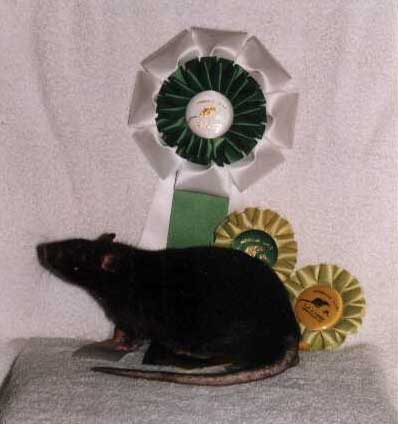Tarot Rats & Mice Quality Rats and Mice for pet and show |
Black Rats History This was one of the first mutations from Agouti ever found as it occurs naturally in the wild population with some frequency. Domesticated Black rats certainly predate the rat fancy, and at the very first show for fancy rats (Aylesbury Town Show, October 24, 1901) Best In Show was a Black and White Even Marked owned by Miss Mary Douglas. The Black has been in the standards since the beginning of the fancy and has coninued down to the present virtually unchanged. |
The Color Black the only thing that distinguishes Black from the wild Agouti color is that it lacks the band of yellow on each hair. Instead, each hair is a solid color throughout. The AFRMA standard describes the ideal Black as "color is a good solid black throughout, showing no rustiness or white hairs.Eye color is black." A really excellent Black will have a solid, unsilvered color over the entire body with dark feet all the way to the ends of the toes and good dark pigment on the ears and tail. Breeding The Black The genetics of the Black Self are very simple. The Agouti locus has 2 alleles, "A" Agouti (or banded hairs) and "a" non-Agouti (solid colored hairs). A Black rat is simply a non Agouti "aa" with no other color genes acting upon it. Black is recessive to all Agouti colors (Agoiti, blue Agoiti, Silver Fawn, Fawn, Lynx, etc.) and if bred to them will produce Agouti babies. All colors of rats are either "Agouti" colors or "Black" colors. Our self rats are black rats. The ones who don't appear black have other color genes acting upon them. Thus, a chocolate rat is aabb, and a Russian Blue is aadd. Blacks have the potential of carying all other recessive colors. Thus, rats like the one pictured above can produce quite surprising results when bred. The rat pictured above (GCh RN Simply Slick) was bred to another Black self, and the resulting litter contained 12 babies in 10 different colors (Black, Blue, Russian Blue, Chocolate, Seal Point Siamese, Blue Point Siamese, Russian Blue Point Siamese, Silver Blue, Platinum, and Dove. When breeding Blacks it is important to select against rustiness, silvering, and white feet. No Black should appear gray from silvering, but often youngsters won't show this fault until they are over 8 weeks old, so this is a variety to select at as old an age as possible. the best combinations to use then breeding for Blacks are Black X Black and Black X DArk Agouti, although Slick was out of a Seal Point Siamese and a Blue, and one of the other best I've seen was out of a Lilac. Blacks are often used to improve the points in Siamese, and consequently a number of excess Blacks are produced. Unfrotunataly, these usually have a considerable amount of silvering, as do most blacks produced from attempts to improve other colors. The trick to consistantly breed for good Blacks seems to be breeding just for Black, as very few show quality animals are produced out of breeding for other colors. Showing The Black Blacks are an excellent choice for a novice to show. There are quite a few out there and picking up a fairly good one at a reasonable price should not be too difficult. The faults on Blacks are easily seen, white feet and silvering being the most prominent. Females are the better show animals as the males tend to silver, however, some females (fewer males) will turn brown. This can be either due to age, molt, sunburning, or genetics. Blacks require little prerparation for a show unless they are really dirty, just a wipe with a soft cloth to eliminate any dust just prior to being placed on the judge's table. If one is really dirty, it can be bathed, but make srue the coat has at least a week to regain it's oils. Otherwise it will appear dull. There are a lot of Blacks around, including some really good ones. Even the best Black must also have excellent conformation to compete with some of the flashier and less abundant colors; however, however, an animal which combines both these traits is a stunning show prospect. |

